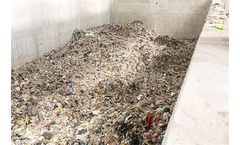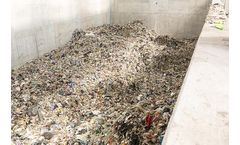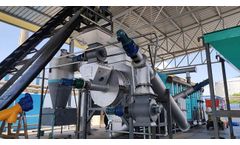waste gasification Articles
-
Measuring Gases Produced by Waste Gasification to Improve Control and Efficiency
Waste gasification is a type of waste to energy process where waste material is used as a fuel to create heat, electricity or other chemical products. Specifically, in waste gasification, the waste material is decomposed in such a way to produce gaseous products, often known as syngas, a combination of hydrogen, carbon monoxide and some carbon dioxide.Conventional incineration uses heat and ...
-
Measuring Gases Produced by Waste Gasification to Improve Control and Efficiency
Waste gasification is a type of waste to energy process where waste material is used as a fuel to create heat, electricity or other chemical products. Specifically, in waste gasification, the waste material is decomposed in such a way to produce gaseous products, often known as syngas, a combination of hydrogen, carbon monoxide and some carbon dioxide.1 Conventional incineration uses heat and ...
-
Analysis of availability and accessibility of hydrogen production: An approach to a sustainable energy system using methane hydrate resources
It is considered that use of hydrogen as an energy source may contribute to environmental improvement and provide an alternative energy system. Moreover, it is anticipated that hydrogen will be in great demand in the near future for use in such vehicles as fuel cell-based cars. Research and development of a number of advanced methods of hydrogen production (OTEC, water photolysis using a ...
-
Solid waste gasification pollution abatement - Case study
Catalytic Products International has partnered with a Gasification System Designer in the design and supply of a unique thermal oxidizer for use with a closed loop batch pyrolysis gasification system. The gasifier is engineered to create a clean combustible syngas from a broad spectrum of dissimilar carbonbased solids, liquids, and other feedstocks. The QUADRANT NR – SEVERE DUTY Thermal ...
-
Green Energy: From Waste to Syngas Production
Syngas production from waste gasification is one way to produce renewable energy. However, varying waste compositions can make gasification challenging to control, resulting in inconsistent syngas compositions. Closely monitoring gas composition and adjusting process conditions during gasification can ensure consistent, high-quality syngas production. Infrared sensors are the ideal solution for ...
-
Hydrogen-rich synthesis gas production from waste wood via gasification and reforming technology for fuel cell application
The purpose of this study was to establish a fuel process for an advanced power generation system in which hydrogen-rich synthesis gas, as the fuel for the molten carbonate fuel cell (MCFC), can be extracted from biomass via gasification and reforming technologies. Experiments on waste wood gasification were performed using a bench-scale gasification system. The main factors influencing hydrogen ...
-
Plasma resource recovery technology –converting waste to energy and valuable products
Abstract Plasma Resource Recovery (PRR) is a revolutionary technology that can treat virtually any type of waste by combining gasification with vitrification. Vitrification produces inert slag that can be used as a construction material. Gasification produces a fuel gas containing carbon monoxide (CO) and hydrogen (H2), used for cogeneration of electricity and steam. The plasma fired eductor ...
-
Energy from biomass and waste – case studies in China
With its vast territory and abundant biomass resources, China appears to have suitable conditions to develop biomass energy. It has long been recognised that it is important to develop advanced technologies for conversion of biomass into clean and convenient fuels in order to raise the efficiency of biomass energy utilisation and alleviate air pollution. Through past efforts some progress in ...
-
Preliminary studies of lignocellulosics and waste fuels for fixed bed gasification
This study was carried out to understand the decomposition behaviour of a range of biofuel and waste feedstock during gasification in a downdraft gasifier. A laboratory scale large sample thermogravimetric analyser (LSTA) is used which allows the data on burn-out characteristics of different fuel particles to be measured under agitated conditions. The conditions chosen simulate the combustion ...
-
Waste-to-Energy Gasification Plant Case Study
Summary: Progressive civic leaders in Covington, Tennessee, knew there was a better solution to disposing of wood waste and sludge – the ACE DDSF-1000 gasifier (12 ...
-
Air gasification of Malaysia agricultural waste in a fluidised bed gasifier
Hydrogen production from agricultural waste has been investigated experimentally using a bench-scale fluidised bed gasifier with 60 mm diameter and 425 mm height. During the experiments, the fuel properties and the effects of operating parameters such as gasification temperatures (800?900?C), fluidisation ratio (2.0?3.33 m/s), static bed height (10?30 mm) and equivalence ratio (0.16?0.46) were ...
-
Green 2 Energy, Coyoacán, Mexico D.F. - Case Study
Green to Energy (G2E) is a renewable energy company located in the colonia of Santa Catarina, in the Coyoacán borough of Mexico City. G2E specializes in biomass gasification for the energy production. They design, develop and implement projects that produce thermal, electrical and mechanical energy using waste biomass. They offer a wide range of solutions for biomass energy from 20 kWe to ...
-
Fluidised bed combustion and gasification of rice husk and rice straw – a state of art review
Rice is cultivated in all the main regions of world. The worldwide annual rice production is 666 million tons for the year 2008. The combustion and gasification of rice husk/rice straw in fluidised bed reactors seems to be an attractive possibility of future for power generation, the solution of waste disposal problems and the reduction of greenhouse gases. In this paper, overview of fluidised ...
-
Determining the viability of a waste-to-energy plant in Africa
Nick Mannie, Aurecon’s waste expert, was invited to deliver a keynote presentation at the African Waste Week conference in early September at the Cape Town International Convention Centre in Cape Town, South Africa. Mannie discussed the development and execution of robust feasibility plans to determine the viability of a waste-to-energy plant. “Waste energy is very topical at the ...
-
Sustainable Agriculture: Biochar Production Equipment's Role
The recycling of agricultural waste has gained significant attention in recent years, driven by the need for sustainable farming practices and environmental responsibility. Central to this movement is the role of biochar production equipment in efficiently converting agricultural waste into biochar, a carbon-rich soil amendment. This article explores the profound impact of biochar production ...
-
Refuse Derived Fuel, Current Practice and Perspectives
Untitled Document Summary I OBJECTIVES The objectives of the project were to undertake a survey on the current practices of production and use of refuse derived fuel (RDF) in the fifteen Member States of the European Union, as well as to undertake an overview of the legal and policy framework of RDF production and use; an assessment of the environmental impacts and of the ...
-
The Beltran biomass cogeneration system
An effective, economical solution for harvesting safe, renewable domestic energy, mitigating wastes and achieving environmental goals. Background The Beltran Biomass Cogeneration System (BBCS) is an integrated, three-stage process that uses proprietary gasification technology to convert biomass and other organic wastes into versatile, cleanburning synthesis gas. The purified gas can then be ...
-
Cleaning Up Gasification Syngas
Documento sin título Introduction By definition, gasification is the art of changing a non-gaseous substance, such as a liquid or a solid, into a gas. By this definition, processes such as combustion, anaerobic digestion and pyrolysis would be classified as gasification. However, in today’s world, gasification is defined as any process, which produces a “synthesis gas” or a ...
-
Advanced, integrated systems meet the challenges of commercial-scale operation
Technological frontiers in die alternative energy industry continue to widen in countries around the globe. As such, die exploitation of biomass as a source of energy has become die fastest-growing sector among a growing roster of energy solutions. Today, more energy is produced from various forms of biomass dian from all wind, solar and geodicrmal applications combined. Much of die excitement ...
Need help finding the right suppliers? Try XPRT Sourcing. Let the XPRTs do the work for you




